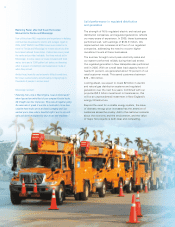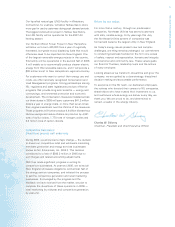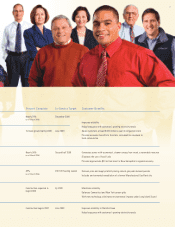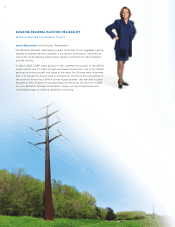Eversource 2005 Annual Report Download - page 16
Download and view the complete annual report
Please find page 16 of the 2005 Eversource annual report below. You can navigate through the pages in the report by either clicking on the pages listed below, or by using the keyword search tool below to find specific information within the annual report.
14
Financial Condition and Business Analysis
Executive Summary
The following items in this executive summary are explained in more
detail in this annual report.
Strategy, Results and Outlook:
•In 2005, Northeast Utilities (NU or the company) recorded losses
of $253.5 million, or $1.93 per share. Those results included net
income after payment of preferred dividends of $163.4 million,
or $1.24 per share, at the regulated Utility Group businesses and
losses of $398.2 million, or $3.03 per share, at the competitive
NU Enterprises businesses.
• On March 9, 2005, NU announced that NU Enterprises would exit
its wholesale marketing business and its energy services businesses.
On November 7, 2005, NU announced its decision to exit the
remainder of NU Enterprises’ competitive businesses, which
includes the retail marketing and competitive generation businesses.
NU expects that exiting the NU Enterprises businesses will benefit
shareholders by producing a company with a simpler,lower risk
business model, and with more predictable financial results and
cash flows. NU expects to use the net proceeds from exiting the
NU Enterprises businesses to reduce debt and make equity
investments in the Utility Group businesses.
• The NU Enterprises 2005 losses of $398.2 million included a
net negative after-tax mark-to-market charge of $278.9 million
on wholesale energy contracts and after-tax restructuring and
impairment charges of $27.3 million.
• Included in these negative mark-to-market charges, in 2005 NU
Enterprises paid or agreed to pay approximately $242 million to
exit all of its New England wholesale energy contracts. Of the
approximately $242 million, in 2005 approximately $186 million
was paid. Also in 2005, NU Enterprises sold two of its energy
services businesses for a total of $6.5 million and part of another
energy services business in January of 2006 for approximately
$2 million.
• Utility Group 2005 earnings increased by $7.8 million or 5 percent
as a result of higher transmission business earnings due to a higher
level of investment, retail distribution rate increases at all four
regulated companies and a 2.6 percent increase in regulated retail
electric sales in 2005. These results wereoffset by after-tax employee
termination and benefit plan curtailment charges totaling $12.3 million,
higher pension, depreciation, and interest expense.
• NU expects the Utility Group to invest up to $4.3 billion in its
electric transmission and distribution and natural gas distribution
businesses from 2006 through 2010. NU estimates that when it
successfully meets this goal, it will achieve significant compounded
annual regulated rate base growth through 2010. After accounting
for the dilutive impact of projected issuances of additional common
shares beyond 2007 and parent company expenses, the company
expects such rate base growth, assuming appropriate regulatory
actions, to result in regulated earnings per share growth of between
8percent and 10 percent annually beginning with 2007.
• NU projects that 2006 combined earnings for the Utility Group and
parent company will be between $1.09 per share and $1.22 per share.
NU is not providing consolidated earnings guidance or guidance for
NU Enterprises due to the uncertainty of any potential financial
impacts of exiting its competitive businesses.
Legislative and Legal Items:
• On July 6, 2005, Connecticut adopted legislation creating a mechanism
to true-up annually the retail transmission charge in local electric
distribution company rates. In accordance with this legislation,
effective January 1, 2006, The Connecticut Light and Power Company
(CL&P) raised its retail transmission rate to collect $21 million of
additional revenues over the first six months of 2006.
• On July 22, 2005, Connecticut also adopted legislation that provides
local electric distribution companies, including CL&P, with financial
incentives to promote construction of distributed generation. The
Connecticut Department of Public Utility Control (DPUC) is conducting
anumber of new dockets to implement this legislation.
• On August 8, 2005, President Bush signed into law comprehensive
federal energy legislation with several provisions affecting NU. As
part of this legislation, the Public Utility Holding Company Act of
1935 (PUHCA) was repealed. Some but not all of the Securities and
Exchange Commission’s(SEC) responsibilities under PUHCA were
transferred to the Federal Energy Regulatory Commission (FERC).
• In an opinion dated October 12, 2005, a panel of three judges at the
United States Courtof Appeals for the Second Circuit (Courtof Appeals)
held that the shareholders of NU had no right to sue Consolidated
Edison, Inc. (Con Edison) for its alleged breach of the parties’ Merger
Agreement. NU’s request for rehearing was denied on January 3,
2006. This ruling left intact the remaining claims between NU and
Con Edison for breach of contract, which include NU’s claim for
recovery of costs and expenses of approximately $32 million and
Con Edison’s claim for damages of “at least $314 million.” NU is
currently considering whether to seek review by the United States
Supreme Court. At this stage, NU cannot predict the outcome of
this matter or its ultimate effect on NU.
• In November of 2005, Public Service Company of New Hampshire
(PSNH) and various legislative, state government and environmental
leaders announced that they had reached a consensus to propose
legislation to reduce the level of mercury emissions from PSNH’s coal-
fired plants by 2013 with incentives for early reductions. As part of the
proposed legislation, PSNH’s primary long-term alternative to comply
with the proposed legislation would be to install wet scrubber technology
at its two Merrimack coal units, which combined generate 433
megawatts (MW), at a cost of approximately $250 million. The proposed
legislation is being considered during the 2006 legislative session.
• The Regional Greenhouse Gas Initiative (RGGI) agreement, signed
on December 20, 2005, is a cooperative effort by the states of
Connecticut, Delaware, Maine, New Jersey,New Hampshire, New
York, and Vermont, to develop a regional program for stabilizing current
levels and ultimately reducing carbon dioxide (CO2)emissions by ten
percent by 2020 from fossil-fired electric generators. RGGI may
impact PSNH’s Merrimack, Newington and Schiller stations. At this
time, the impact of this agreement on NU cannot be determined.
MANAGEMENT’S DISCUSSION AND ANALYSIS
























